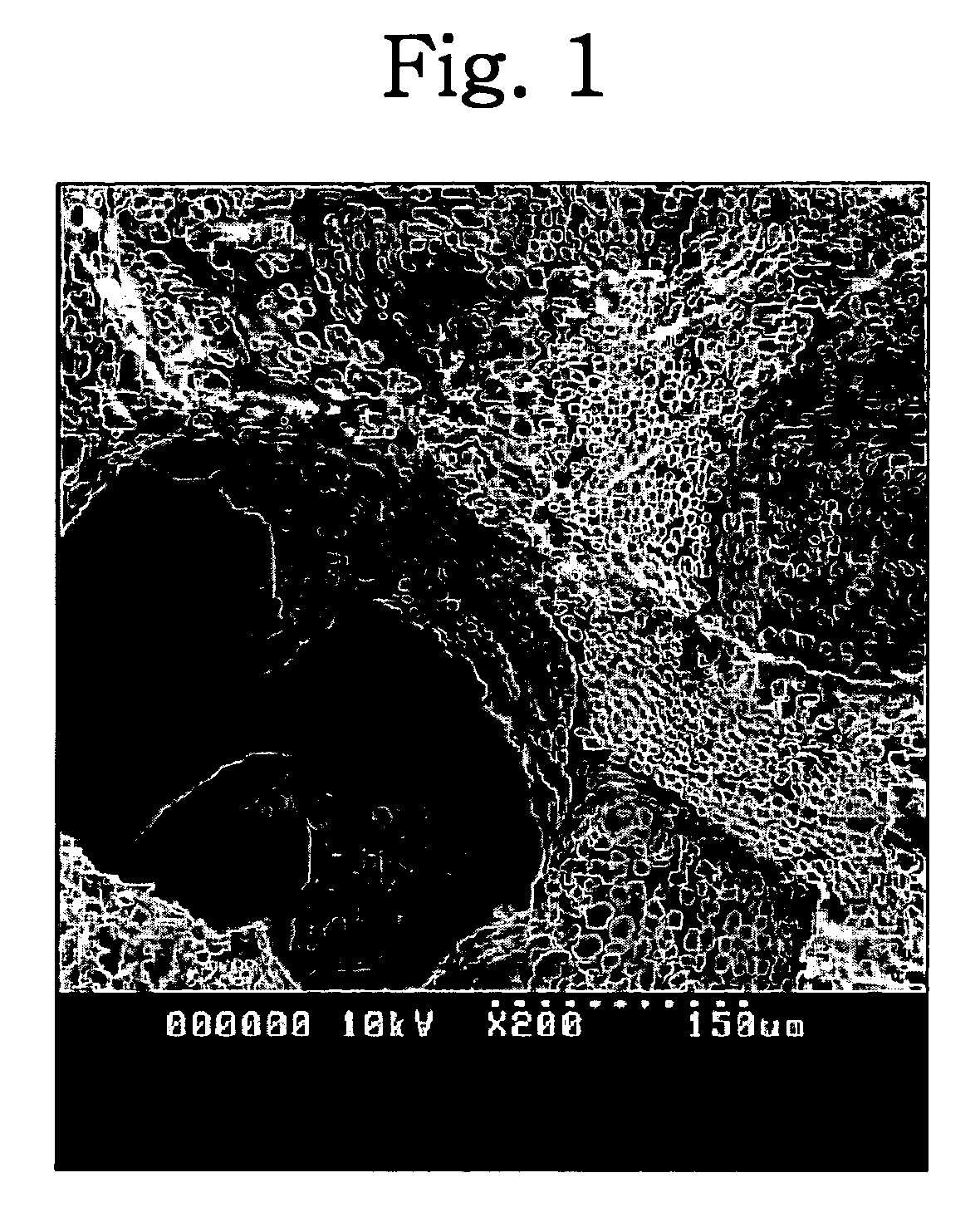Method of preparing biodegradable dual pore polymer scaffolds for tissue engineering
a polymer scaffold and biodegradable technology, applied in the direction of prosthesis, bandages, pharmaceutical delivery mechanisms, etc., can solve the problems of low surface area and porosity of the resultant polymer scaffold, difficult to control the pore size of the scaffold, etc., and achieve high porosity and surface area
- Summary
- Abstract
- Description
- Claims
- Application Information
AI Technical Summary
Benefits of technology
Problems solved by technology
Method used
Image
Examples
example 1
[0039] A poly(lactic-co-glycolic acid) copolymer (PLGA) containing lactic acid and glycolic acid in the weight ratio of 50:50 and having an average molecular weight of about 100,000 was added to a mixed solution of dioxane and water (85:15 w / w) and uniformly dissolved therein by using a magnetic stirrer to provide a 5% by weight of PLGA solution. Then, the effervescent mixture (size of 200-300 μm) of sodium hydrogen carbonate and citric acid (3:1 in molar ratio) was added thereto so that the weight ratio of the effervescent mixture to PLGA was 20 / 1, and uniformly mixed therein. The mixed solution was poured into a frame made of silicone material, which has a shape of a donut having a diameter of 8 mm, and followed by placing the same in liquid nitrogen at −196° C. to evaporate the solvent to some extent, thereby obtaining a polymer sample having a disk shape. Then, the polymer sample was added to a mixed aqueous solution of water and ethanol (50:50 w / w) and subjected to foaming for ...
example 2
[0041] Biodegradable dual pore polymer scaffolds were prepared according to the same process as described in Example 1. However, poly (L-lactic acid) (PLLA) having an average molecular weight of about 2,000,000 was dissolved in dichloromethane to obtain a 13% by weight of PLLA solution. Further, an effervescent mixture (3:1 w / w ratio of 200-300 μm to 5-30 μm of particle size) of sodium carbonate and citric acid (1:1 in molar ratio) was added so that the weight ratio of the effervescent mixture to PLLA was 5 / 1. After foaming, vacuum drying was performed at 40° C. The overall porosity of the scaffolds thus prepared was about 96%.
[0042] Then, the outer surface of the obtained dual pore polymer scaffolds was observed by using a scan electron microscopy, of which the result was similar to that of FIG. 1. That is, the pore shape and distribution of outer surface and inner cross-section of the scaffolds are almost identical. Also, the size of large pores is similar to the particle size (2...
example 3
[0043] Biodegradable dual pore polymer scaffolds were prepared according to the same process as described in Example 1. However, poly(lactic-co-glycolic acid) copolymer (PLGA) (75:25 w / w) having an average molecular weight of about 20,000 was dissolved in a mixed solution of acetone and ethanol (90: 10 w / w) to obtain a 8% by weight of PLGA solution. The temperature allowed was −70° C. An effervescent mixture (300-400 μm in size) of ammonium hydrogen carbonate and tartaric acid was added. After foaming, vacuum drying was performed at ambient temperature. The overall porosity of the scaffolds thus prepared was about 93%.
[0044] Then, the outer surface of the obtained dual pore polymer scaffolds was observed by using a scan electron microscopy, of which the result was similar to that of Example 1. Further, the pore shape and distribution of outer surface and inner cross-section of the scaffolds are almost identical. Also, the size of large pores is similar to the particle size (300-400...
PUM
| Property | Measurement | Unit |
|---|---|---|
| Temperature | aaaaa | aaaaa |
| Percent by mass | aaaaa | aaaaa |
| Percent by mass | aaaaa | aaaaa |
Abstract
Description
Claims
Application Information
 Login to View More
Login to View More - R&D
- Intellectual Property
- Life Sciences
- Materials
- Tech Scout
- Unparalleled Data Quality
- Higher Quality Content
- 60% Fewer Hallucinations
Browse by: Latest US Patents, China's latest patents, Technical Efficacy Thesaurus, Application Domain, Technology Topic, Popular Technical Reports.
© 2025 PatSnap. All rights reserved.Legal|Privacy policy|Modern Slavery Act Transparency Statement|Sitemap|About US| Contact US: help@patsnap.com

